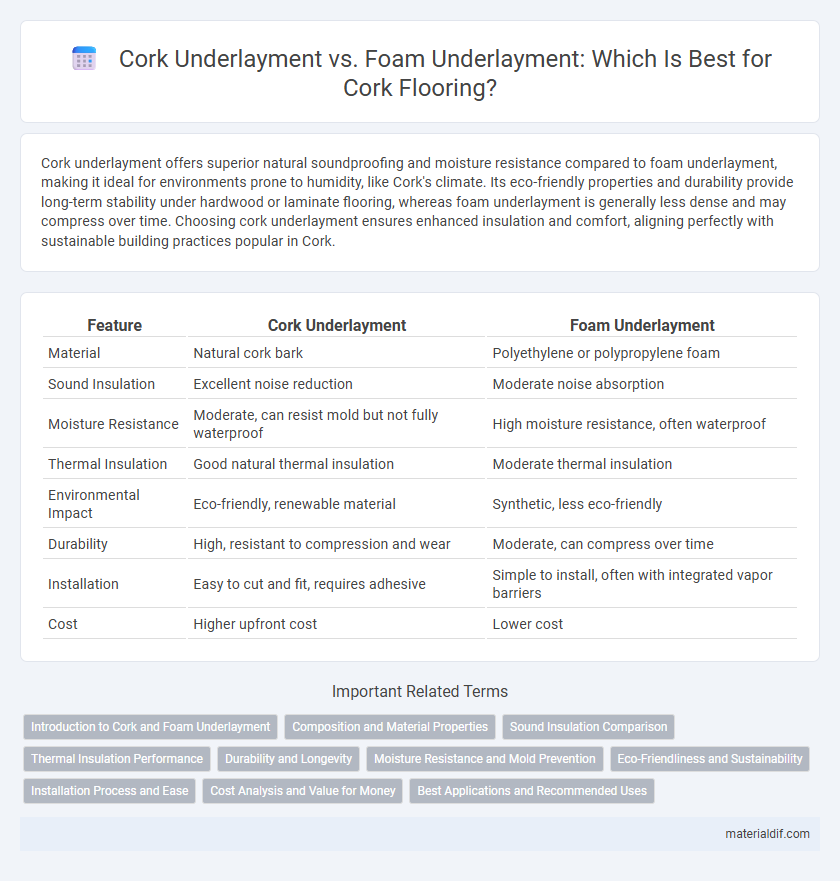Cork underlayment offers superior natural soundproofing and moisture resistance compared to foam underlayment, making it ideal for environments prone to humidity, like Cork's climate. Its eco-friendly properties and durability provide long-term stability under hardwood or laminate flooring, whereas foam underlayment is generally less dense and may compress over time. Choosing cork underlayment ensures enhanced insulation and comfort, aligning perfectly with sustainable building practices popular in Cork.
Table of Comparison
| Feature | Cork Underlayment | Foam Underlayment |
|---|---|---|
| Material | Natural cork bark | Polyethylene or polypropylene foam |
| Sound Insulation | Excellent noise reduction | Moderate noise absorption |
| Moisture Resistance | Moderate, can resist mold but not fully waterproof | High moisture resistance, often waterproof |
| Thermal Insulation | Good natural thermal insulation | Moderate thermal insulation |
| Environmental Impact | Eco-friendly, renewable material | Synthetic, less eco-friendly |
| Durability | High, resistant to compression and wear | Moderate, can compress over time |
| Installation | Easy to cut and fit, requires adhesive | Simple to install, often with integrated vapor barriers |
| Cost | Higher upfront cost | Lower cost |
Introduction to Cork and Foam Underlayment
Cork underlayment is a natural, renewable material derived from the bark of cork oak trees, known for its excellent sound insulation and moisture resistance properties. Foam underlayment, typically made from polyethylene or polyurethane, offers superior cushioning and thermal insulation ideal for laminate and engineered hardwood flooring. Both options enhance flooring comfort, but cork underlayment excels in eco-friendliness and durability, while foam underlayment provides cost-effective impact absorption.
Composition and Material Properties
Cork underlayment is made from natural cork harvested from cork oak trees, offering excellent elasticity, sound absorption, and moisture resistance due to its cellular structure. Foam underlayment, typically composed of polyethylene or polyurethane foam, provides superior cushioning and thermal insulation but lacks the natural breathability and eco-friendly properties of cork. Cork's renewable origin and durability make it ideal for sustainable flooring projects, whereas foam underlayment excels in affordability and impact resistance.
Sound Insulation Comparison
Cork underlayment provides superior sound insulation compared to foam underlayment due to its natural density and cellular structure that effectively dampens impact and airborne noises. In residential and commercial buildings in Cork, cork underlayment reduces noise transmission by up to 50% more than typical foam options, making it ideal for multi-story constructions and shared walls. Foam underlayment, while cost-effective and easier to install, generally offers lower sound absorption, making cork the preferred choice for enhanced acoustic comfort.
Thermal Insulation Performance
Cork underlayment offers superior thermal insulation due to its natural cellular structure, which effectively reduces heat transfer and enhances energy efficiency in buildings. Foam underlayment provides decent thermal insulation but typically lacks the eco-friendly properties and breathability that cork delivers. In residential and commercial applications, cork underlayment's ability to maintain consistent indoor temperatures makes it a preferred choice for sustainable thermal performance.
Durability and Longevity
Cork underlayment offers superior durability and longevity due to its natural resistance to moisture, mold, and mildew, making it ideal for high-traffic areas in Cork homes. Foam underlayment, while providing good cushioning, tends to compress over time and is less resistant to wear and environmental factors, resulting in a shorter lifespan. Choosing cork underlayment ensures a more resilient and long-lasting flooring foundation in Cork's variable climate.
Moisture Resistance and Mold Prevention
Cork underlayment offers superior moisture resistance and natural antimicrobial properties, making it highly effective in mold prevention compared to foam underlayment. Foam underlayment is more susceptible to moisture absorption, increasing the risk of mold growth in damp environments. Cork's dense, impermeable structure provides a durable barrier that enhances indoor air quality and longevity of flooring installations in humid areas like Cork.
Eco-Friendliness and Sustainability
Cork underlayment offers superior eco-friendliness and sustainability compared to foam underlayment, as it is harvested from renewable cork oak trees without causing harm, ensuring a biodegradable and recyclable product. Its natural cellular structure provides excellent insulation and moisture resistance without relying on petrochemical-based materials typical in foam underlayments. Choosing cork underlayment reduces environmental impact through its carbon-neutral production process and contributes to healthier indoor air quality by avoiding toxic off-gassing common in synthetic foam options.
Installation Process and Ease
Cork underlayment requires precise cutting and fitting due to its rigid, natural composition, often necessitating a moisture barrier and adhesive for secure installation, making the process somewhat labor-intensive but highly durable. Foam underlayment, typically lightweight and flexible, allows for quick and straightforward installation with simple roll-out and trimming, often featuring self-adhesive strips for ease. The ease of installation in foam underlayment makes it ideal for DIY projects, while cork underlayment demands more careful handling and preparation but offers superior sound absorption and resilience.
Cost Analysis and Value for Money
Cork underlayment generally costs between $1.50 and $3.00 per square foot, offering natural soundproofing and moisture resistance, making it a durable investment for noise reduction and longevity. Foam underlayment ranges from $0.30 to $0.70 per square foot, providing budget-friendly cushioning but typically lacking in durability and eco-friendliness compared to cork. When evaluating value for money, cork underlayment's higher initial price is offset by its superior insulation and lifespan, making it cost-effective for long-term use in Cork homes.
Best Applications and Recommended Uses
Cork underlayment excels in sound insulation and moisture resistance, making it ideal for use in living rooms, bedrooms, and areas with radiant floor heating. Foam underlayment offers superior cushioning and affordability, best suited for laminate flooring installations in low-traffic areas or basements. Both materials enhance floor durability, but cork is preferred for eco-friendly, natural solutions, while foam serves well where cost-effectiveness and impact absorption are priorities.
Cork Underlayment vs Foam Underlayment Infographic

 materialdif.com
materialdif.com